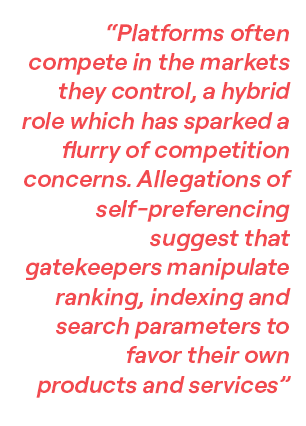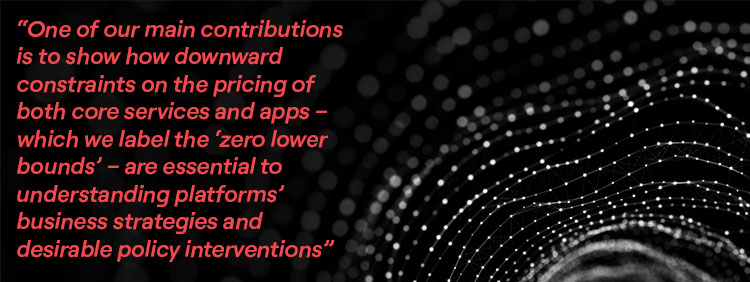Platforms are the keymasters of the digital economy, controlling access to billions of consumers for sellers, app developers and advertisers. A new study by Jean Tirole and his PhD student Michele Bisceglia unpicks the gatekeeping strategies of tech giants such as Amazon, Google and Meta, and their impact on other businesses. In line with TSE Digital Center’s core ambitions, the researchers also provide a framework for assessing regulatory efforts to protect consumers and encourage healthy competition and innovation.
What are regulators’ key concerns about access to digital ecosystems?
 Gatekeeping platforms control access to consumers who use their “core services”, such as those of an app-store, search engine, e-commerce marketplace or social network. Recent regulatory guidelines echo earlier public-utility regulations and the antitrust treatment of essential facilities. For example, Europe’s Digital Market Act (DMA) and US proposals for the Innovation and Choice Act and Open App Markets Act require that business users be given equal access to core services and receive a fair share of their contribution to the ecosystem.
Gatekeeping platforms control access to consumers who use their “core services”, such as those of an app-store, search engine, e-commerce marketplace or social network. Recent regulatory guidelines echo earlier public-utility regulations and the antitrust treatment of essential facilities. For example, Europe’s Digital Market Act (DMA) and US proposals for the Innovation and Choice Act and Open App Markets Act require that business users be given equal access to core services and receive a fair share of their contribution to the ecosystem.
Platforms often compete in the markets they control, a hybrid role which has sparked a flurry of competition concerns. In particular, allegations of self-preferencing suggest that gatekeepers manipulate ranking, indexing and search parameters to favor their own products and services. In 2017, for instance, the European Commission fined Google for abusing its dominance, systematically giving prominent placement to its shopping comparison service and demoting rivals in search results. Even “pure” platforms – like Airbnb or Booking, which operate markets, but do not compete in them – may enter “sweet deals” with specific business users.
Another key concern is the size of platform fees charged to merchants and apps. A number of ongoing antitrust cases – including Epic Games v. Apple; and Spotify v. Apple – concern third-party apps trying to circumvent the 30% app-store fee they deem unfairly high. Since the Covid-19 pandemic began, many local governments in the US have introduced 15% caps on the commissions imposed on restaurants by food delivery platforms such as Uber Eats, Grubhub and DoorDash.
What are the challenges for researchers seeking to evaluate gatekeepers’ strategies and regulatory responses?
The DMA’s suggestion that access conditions be fair, reasonable and non-discriminatory leaves open the question of what we define as “fair and reasonable”. In addition, measurement issues are a considerable challenge. In practice, ancillary benefits accruing to app providers from attracting a consumer (such as advertising revenues, data collection, sale of premium services, or repeat purchases) vary substantially across different app categories. For instance, social media and food delivery apps sell much more personal data to third-party advertisers than video-conferencing apps. Is a merchant fee of 20% or 30% appropriate? Information asymmetries can confound any assessment as industry knowledge is often beyond the reach of the regulator.
Much of the existing research on platforms ignores a crucial feature of the digital economy: core services and digital goods are often offered to consumers for free. This is the case for most apps in Google Play and Apple’s app store, including common third-party apps (e.g., PayPal, Dropbox basic version) and their in-house competitors (e.g., Apple Pay and Google Pay, the basic versions of iCloud and Google Drive). Free access implies that platforms and apps would prefer to pay their users. However, negative prices would likely attract bots and other fake consumers who would not buy (and a fortiori repeat their purchase), respond to ads, or supply useful data. A zero price on the consumer side is not guaranteed, as it hinges on the platform’s ability to monetize the consumer’s data or the other sides of the market – namely, third-party sellers and advertisers.
How does your research help regulators to police the digital landscape?
Our framework provides a first answer to the question of how to enable business users – such as third-party app developers and merchants – to get their “fair share” for their contribution to a digital ecosystem. Our basic model considers a two-sided platform that levies a per-unit access charge on third-party app sales, charges a non-negative access price to consumers, and sells (in the basic version of the model) its own in-house apps in competition with third-party sellers. App developers receive ancillary benefits from attracting a consumer.
One of our main contributions is to show how downward constraints on the pricing of both core services and apps – which we label the “zero lower bounds” –are essential to understanding platforms’ business strategies and desirable policy interventions. These non-negative price constraints generate undesirable outcomes that include, depending on the level of the access charge: undue business-user profits, with the consequent incentive for the platform to engage in “self-preferencing”; and the squeezing of business users.

Overall, we demonstrate the need for overseeing the terms and conditions offered by platforms to business users. While we welcome the DMA and other regulatory efforts, the specific recommendations remain insufficiently clear. We show that leaving platforms free to implement their preferred access policies creates unfair access conditions. The zero lower bounds also prevent platform competition from solving this gatekeeping problem. Platform competition for single-homing consumers is too unfriendly to business users, and app-store competition under consumer multi-homing is too favorable to business users.
Our second main insight is to show that the optimal access charge is equal to the ancillary benefit obtained by the apps when acquiring a customer. By discouraging denial of access, this level provides app developers with a fair return and a proper incentive to innovate.
What are the next steps for research in this area?
Our theoretical benchmark needs to be matched with the development of an empirical methodology to measure the relevant data. This remains as difficult as it is essential. We do examine some of the relevant considerations, comparing regulatory schemes that aim to elicit the value of ancillary benefits from the industry. But more work is necessary to tame the gatekeeping platforms while encouraging them to continue offering innovative services.
FURTHER READING
‘Fair Gatekeeping in Digital Ecosystems’ is available to read on the TSE website.
Article published in TSE Reflect, October 2023





